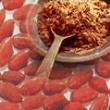Marked variability in red yeast rice products
 Red yeast rice is an alternative therapy to treat high cholesterol levels. It contains monacolins that may inhibit HMG-CoA reductase — the enzyme inhibited by statins.
Red yeast rice is an alternative therapy to treat high cholesterol levels. It contains monacolins that may inhibit HMG-CoA reductase — the enzyme inhibited by statins.
Researchers at Chestnut Hill Hospital, in Philadelphia, Pennsylvania, report marked variability of monacolin and citrinin content in 12 readily available red yeast rice products.
First, the details.
- 12 commercially available red yeast rice products were analyzed for total monacolin, monacolin K (lovastatin; Mevacor) and monacolin KA content.
- Citrinin, a contaminant that is toxic to the kidney, was also measured.
- Testing was performed by ConsumerLab (White Plains, NY).
- Each product was labeled 600 mg/cap of active product.
And, the results.
- There was marked variability in content
- Total monacolins (0 to 11 mg/cap)
- Monacolin K (0 to 10 mg/cap)
- Monacolin KA (0 to 2 mg/cap)
- 4 products had elevated levels of citrinin.
The bottom line?
The authors concluded, “There is striking variability in monacolin content and the presence of citrinin in one-third of the products tested.”
Red yeast rice is used by millions of people worldwide as an alternative lipid lowering therapy. It reduces both LDL (bad) cholesterol levels and the risk of heart attacks.
However, these results should cause patients and healthcare providers to pause.
Until we can rely on supplement manufacturers to provide consistent high quality control, physicians and patients should be cautious in recommending or using red yeast rice to treat high cholesterol and cardiovascular disease.
9/20/10 22:01 JR